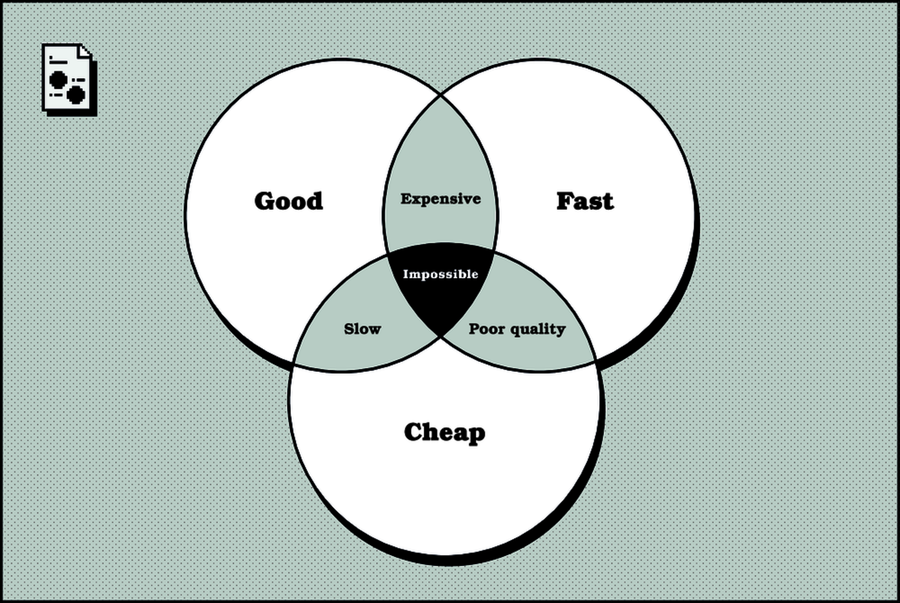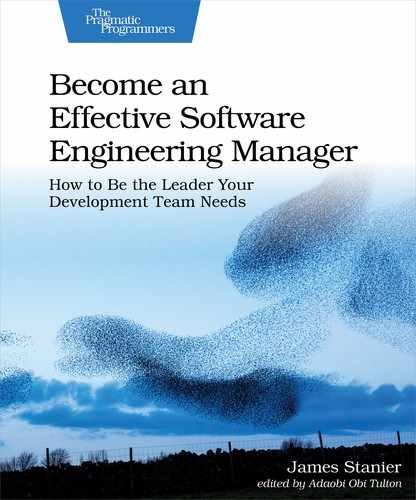Picking Who to Hire
Clearly before you start hiring you should know who exactly you want to hire. This might sound like one of the most obvious statements in the world, but there are subtleties to finding the right people to make your team even more effective. Hiring managers fall into some common traps when given the ability to hire anyone into their team:
-
They just hire more engineers. No matter what the problem is, just throw more engineers at the problem, right?
-
They just hire the most senior person possible. Surely the most senior candidate will have seen it all before. Forget about these people with only a few years’ experience. Let’s just get the experts in, surely?
-
They hire people just like themselves. Culture fit means “one of us,” doesn’t it?
Wrong! There’s much more to putting together a highly functional team than just finding seven carbon copies of yourself. Remember that as a manager, you are trying to find ways to increase your output, where your output is defined as:
Teams are interdependent by nature. In technology we work on complex problems that benefit from a diverse range of skill sets, experiences, and viewpoints to produce the best possible work. Today’s cross-functional team typically consists of engineers, one or more designers, one or more QA, an agile practitioner, a product manager, and an engineering manager: fully functional teams that can build software from end to end. Assuming you aren’t replacing a member of staff that has departed—and even if you are—an opportunity to hire is an opportunity to pause and look at the team as a whole.
Think of the following:
-
In a typical week, where does the team tend to slow down or get blocked? For example, do tasks bottleneck on QA, or are there simply not enough back-end engineers to balance the output of the front-end engineers?
-
Which is the area of your team that has the least seniority? Are there dependencies outside of the team for any particular type of work where it would be advantageous to have that support inside the team instead?
-
What is the team’s opinion on where they are lacking support? Who would they add if they were choosing?
Before you rush to pull the trigger on hiring yet more engineers, step back and consider the whole interdependent team and seek their opinion on the matter. It may be the case that adding an additional QA engineer will be more effective for increasing the overall output of the team when compared to adding another JavaScript developer who adds to the throughput bottleneck. Likewise, if the team is often dealing with complex streams of work and has difficulties with prioritization and organization, then it might be more valuable to hire an agile practitioner to focus on team efficiency rather than making it even more disorganized. Don’t just opt to throw engineers at the problem regardless. It’s up to you to optimize for the whole team’s output.
More Talent Isn’t Always Necessary
In addition to picking the right skill sets to add to the team, you should also be looking to find someone who is the right level of seniority. “But,” I hear you cry, “shouldn’t we just get the most senior people possible?” That’s a good question. And most certainly you should be trying to hire excellent seniors. However, this isn’t always the easiest thing to do, nor is it always the best solution to your situation. A couple of reasons explain why.
Are you familiar with the classic project management constraints, typically called the iron triangle or triple constraint? It states that you can model an ideal project with three categories: good, fast, and cheap.

However, it states that in reality your project will typically fall into two of these categories, but not all three:
- A good and fast project will not be cheap.
- A fast and cheap project will not be good.
- A good and cheap project will not be fast.
Hiring parallels this, and we can slightly rework the iron triangle definition to capture the dilemma that you will face as a hiring manager:
-
A senior hire made quickly will probably not be in budget. Typically, fast senior hires will require headhunting, which means bringing out the big bucks to coax people away from their current jobs and potentially paying expensive recruiter fees.
-
A fast hire that is within budget will probably not have all of the experience that you want. You’re at the whim of whoever is actively looking for jobs at the time that you put your advert out.
-
A perfect senior hire that is within budget may not happen on the timescale that you want (that is, now).
Given that you have a headcount in your team to fill, presumably because the business wants you to maintain or increase your output, you can’t wait forever to fill that vacancy. So as a manager you’ll need to do the best that you can, within the budget that you have, within a reasonable timescale. What this means is that you’ll be writing job adverts and interviewing for the potential of candidates to grow as much as you are assessing their current skill set. You’ll see that we won’t be writing job adverts that have a long laundry list of exact skills for your team. We’ll be promoting an opportunity to experience something new and to grow.
Don’t feel dismay that you’re never going to get the perfect candidate every time. It has been shown that there can actually be such a thing as too much seniority in teams. A study showed [SSAR14] that in sports that have highly interdependent teams, such as soccer and basketball, there can be such a thing as too much talent! This contradicts the popular belief that there is a monotonic relationship between talent and performance; that is, the primary way to increase performance is to increase the amount of talent within a team. What the study found is that in interdependent team sports, an increase in talent increases performance to a point, after which further increases in talent become detrimental as the coordination within the team suffers.
This can happen because a winning team may have one or two stars that the rest of the team coordinates round to use them to their full effect. When assembling a team of all-stars, the natural order of the team begins to fall apart: in a team where each player is usually the center of attention in the game, how will a new pecking order form? Often it doesn’t, and an all-star team can get beaten by one that is more collaborative but less individually talented.
But we’re not playing sports, are we? We’re building software. Yet, there are many parallels to overstaffing a team with seniors. For example, seniors may be used to pointing in a particular direction and then having the rest of the team align and support them in getting there. Too many strong opinions may cause conflict and disarray rather than getting there twice as fast. Additionally, a good balance of senior staff with those that are less experienced gives plenty of mentoring opportunity for the senior, which in turn improves the whole team in an interconnected, interdependent manner.
So perhaps the fact that you’re not going to find the exact fit for your role every time doesn’t matter. Instead, see hiring as an opportunity to find people that are motivated to learn, grow, and overcome challenges together. Those are the people that will elevate the whole team and improve it in the long run. Not only will you wait forever to hire three LeBron Jameses, they might actually end up falling out over who gets to take the shots.
A Note on Culture Fit
The last part of thinking about who to hire is not something you will explicitly seek, but instead is something that you should be open to. I’m sure that you’ve probably heard all about “culture fit” and what it means to ensure that the people you hire adhere to it. It could be argued that culture fit is impossible as a concept: culture, unless monolithic and dictatorial, is not possible to “fit” into. People instead add or contribute to a culture.
Before you start filling your mind with visualizations of the hypothetical person that you’re going to find for your team, remember that you’re looking for the following traits when assessing for their suitability:
- Motivation
- Willingness to learn
- Collaboration skills
- Good communication
- Empathy and kindness
- A diverse background and viewpoint
- Alignment with both the company’s and your values and ethics
But not these:
- A background or education similar to yours
- Their sense of humor
- Someone you’d enjoy going drinking with
- Someone who has the same hobbies as you
We’ll look at how to assess these traits in the sections that follow, but get it out of your mind now: you should not be looking for someone just like you.
So, before we move on to writing the job description, think about who you want to add to your team.
-
Where is your team lacking right now?
-
Does the team agree with your judgment here?
-
What skill set should the new hire have?
-
What sort of seniority would be desirable and acceptable for the dynamics of the whole team?
-
What sort of budget is the company allocating for the role, and how does that complement or detract from the person that you’re ideally after?
When you’ve thought about what sort of role you want to advertise for, you’ll need to get a job description together. We’ll do that next.
On Hiring Friends | |
|---|---|
|
|
Should you hire your friends? Of course you should, assuming you want to do so because they are good at what they do and you think they will fit in well at the company. However, you should be mindful of some things when recommending your friends for roles:
|
